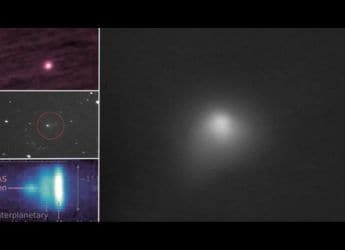- Home
- Science
- Science News
- New Rogue Planet Discovered in Hubble Data Using Einstein’s Gravity Theory
New Rogue Planet Discovered in Hubble Data Using Einstein’s Gravity Theory
A rogue planet was found in Hubble data using Einstein’s microlensing; event lasted 8 hrs and no host star was detected.

Photo Credit: Robert Lea / NASA
Hubble spots rogue planet bending light via gravitational lensing while in Earth orbit
Astronomers found that a new rogue planet hides in the archival data that was gathered by the Hubble Space Telescope with the help of Albert Einstein and the happening of the events by chance, leading to success. These planets are also known as free-floating planets and do not orbit a star. These are just ejected from their home systems because of the planetary interactions. As they lack a host star, it is difficult to detect them by transit. However, the astronomers use microlensing with gravity, Einstein's 1915 theory-based phenomenon of general relativity, in which massive objects warp space and bend light from the background stars.
Einstein's Theory Helps Detect Hidden Rogue Planet
According to As per Przemek Mroz, a professor at the University of Warsaw free free-floating planets don't orbit any star and drift alone through the galaxy. In order to find such objects, we need to use the technique of gravitational microlensing. At the time of using this technique, the light of the background star gets magnified temporarily. The physicists estimate the mass of the object by analysing the properties of the event.
The newly found event of microlensing, OGLE-2023-BLG-0524, was seen by Hubble on May 22, 2023. Observed by KMTnet, the event only lasted for eight hours and was discovered in the Galactic bulge by the OGLE survey. The team ruled out the presence of a host star; however, very nearby elements can't be excluded completely.
Microlensing Event Reveals Free-Floating Planet in Hubble Data
The lens and source are more relative to each other; the physicists confirm the status of the object over time. The movement of 5 milliseconds per year could take 10 years to resolve with the recent instruments.
Hubble's data from 1997 let the scientists rule out the bright host stars. Mroz said that if the lens were a bright star, we would have observed it, but we could not. This absence evoked 25%-48% of the possible stellar companions. This research is available on arXiv.
Get your daily dose of tech news, reviews, and insights, in under 80 characters on Gadgets 360 Turbo. Connect with fellow tech lovers on our Forum. Follow us on X, Facebook, WhatsApp, Threads and Google News for instant updates. Catch all the action on our YouTube channel.
Related Stories
- Samsung Galaxy Unpacked 2025
- ChatGPT
- Redmi Note 14 Pro+
- iPhone 16
- Apple Vision Pro
- Oneplus 12
- OnePlus Nord CE 3 Lite 5G
- iPhone 13
- Xiaomi 14 Pro
- Oppo Find N3
- Tecno Spark Go (2023)
- Realme V30
- Best Phones Under 25000
- Samsung Galaxy S24 Series
- Cryptocurrency
- iQoo 12
- Samsung Galaxy S24 Ultra
- Giottus
- Samsung Galaxy Z Flip 5
- Apple 'Scary Fast'
- Housefull 5
- GoPro Hero 12 Black Review
- Invincible Season 2
- JioGlass
- HD Ready TV
- Laptop Under 50000
- Smartwatch Under 10000
- Latest Mobile Phones
- Compare Phones
- Poco F8 Ultra
- Poco F8 Pro
- Huawei Mate 80 RS Master Edition
- Huawei Mate 80 Pro Max
- Huawei Mate 80 Pro
- Huawei Mate 80
- Huawei Mate X7
- Honor 500
- Asus ProArt P16
- MacBook Pro 14-inch (M5, 2025)
- Poco Pad M1
- Poco Pad X1
- Honor Watch X5
- Huawei Watch Ultimate 2
- Acerpure Nitro Z Series 100-inch QLED TV
- Samsung 43 Inch LED Ultra HD (4K) Smart TV (UA43UE81AFULXL)
- Asus ROG Ally
- Nintendo Switch Lite
- Haier 1.6 Ton 5 Star Inverter Split AC (HSU19G-MZAID5BN-INV)
- Haier 1.6 Ton 5 Star Inverter Split AC (HSU19G-MZAIM5BN-INV)

















